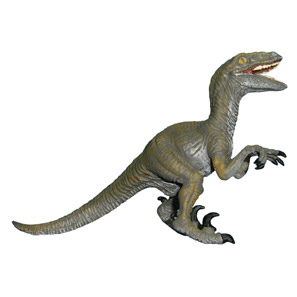Staring Open Mouthed at Models
Dinosaur Models – Why are most of them shown with their Mouths Open?
Why do most dinosaur models have their mouths wide open? Animals around today do not walk around with their mouths agape.
When it comes to designing dinosaur and other prehistoric animal models, the artists and sculptors take great care, trying to ensure that their particular model reflects the latest scientific thinking. Staff at Everything Dinosaur get involved in this process and we have been consulted on a number of aspects related to prehistoric animal models; from suggestions as to which models should be made, to advising on anatomical features and colouration. Interestingly, sometimes life can imitate art, for many years we were most insistent that models depicting members of the Pteranodontidae were toothless, now toothed forms of Late Cretaceous pterosaurs have been named and described, muddying the water somewhat.
Dinosaur Models
However, most model makers attempt to depict the animals as accurately as possible, although liberties are taken with a number of bipedal models. For example, to make a dinosaur model that stands on its two hind legs stable; the feet may have to be made slightly over-sized, or the tail position adjusted to give a tripod effect, helping the model stay upright. This is most noticeable in models of dromaeosaurs and maniraptorans. These type of dinosaurs walked on two toes, not the normal theropod three, so feet have to be adjusted accordingly to help the model remain stable.
A Typical Dromaeosaur Model (Big Feet)
Picture credit: Everything Dinosaur
To view this Velociraptor model and other theropod dinosaur models: CollectA Prehistoric Life Age of Dinosaurs Models.
Models do get makeovers from time to time, with new colour variants being added. This is a cheap way of refreshing a range without the need to introduce new sculpts. There is nothing wrong with this, as afterall, since pigment rarely fossilises the colour of a prehistoric animal such as a dinosaur is largely speculative.
Dinosaur Replicas
One of the interesting points that we often make to designers is that they are preoccupied with showing the animal with its mouth open. Whether it is a meat-eater such as Tyrannosaurus rex, Allosaurus or even a Sabre-toothed cat, or indeed a herbivore such as Stegosaurus or Triceratops, mouth open models seem the order of the day.
Anyone observing how animals move around, a study of your pet dog or cat, perhaps watching a pride of lions on a television programme and you will see that most animals keep their traps shut for most of the time. Teeth and open jaws are more exciting for model makers, but the reality is most animals keep their mouths closed, in essence only opening their mouths to communicate, make threat gestures, attack or to eat. We do point this out when advising sculptors and the like, but we suspect that there are going to be lots more open mouthed dinosaurs made.
The London Natural History Museum’s Large T. rex Model
Picture credit: Everything Dinosaur
The Tyrannosaurus rex dinosaur model (above), is from the London Natural History Museum model series. To view this exciting range of prehistoric animal models: Natural HistoryMuseum Dinosaur Models.
Whilst the gape is impressive and the paint job on the teeth is very good, T. rex would not have walked around all day with his mouth wide open. However, a closed mouth T. rex is perhaps not as appealing and so the open mouthed Tyrannosaurus model seems here to stay.



